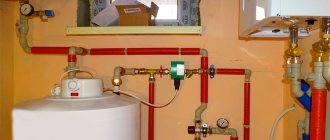Changes in 2019 that affected heating
When calculating heating payments in apartment buildings, some parameters have changed:
- There were two heating options, it was divided into 2 categories: individual and communal.
- We have developed special formulas for calculating those square meters and rooms that are not heated, and for residential areas with autonomous heating.
- Individual calculation of heating payments has appeared in multi-apartment buildings, which are only partially equipped with heat meters.
Also, for a more detailed calculation, new indicators were introduced that affect the amount of payment. Such as the area of common areas and the amount of Gcal of heat consumed. This value is the sum of the indicators that were taken from individual heat metering equipment or installed on the heating systems of the owners of radiator distributors.
How to calculate the amount yourself
You can calculate the amount of payment for heating in your apartment yourself. But before that, consider some factors:
- Determine how many months a year the payment for heat occurs. Only for the period when hot water is supplied to the batteries or throughout the calendar year.
- Find out if your apartment building has a communal heat meter installed.
- Find out whether your living space is equipped with a separate heat meter or its own radiator distributors.
- Determine how the heating system in your living space is filled with hot water. Via the central city system or through special equipment installed in your home.
Based on these parameters, you can use certain formulas to calculate payments for heating an apartment.
How to calculate the heating payment for your apartment?
Comments
The question of calculating the amount of payment for heating is very important, since consumers often receive quite impressive amounts for this utility service, at the same time having no idea how the calculation was made.
Procedure for calculating heating fees
Since 2012, when the Decree of the Government of the Russian Federation of May 6, 2011 No. 354 “On the provision of utility services to owners and users of premises in apartment buildings and residential buildings” came into force, the procedure for calculating the amount of heating fees has undergone a number of changes.
Calculation methods changed several times, heating provided for general house needs appeared, which was calculated separately from heating provided in residential premises (apartments) and non-residential premises, but then, in 2013, heating again began to be calculated as a single utility service without splitting the fee.
The calculation of the heating fee has changed since 2021, and in 2019 the calculation procedure changed again; new formulas for calculating the heating fee have appeared, which are not so easy for an ordinary consumer to understand.
In order to calculate the heating fee for your apartment and choose the necessary calculation formula, you must first know:
1. Does your house have a centralized heating system?
This means whether the thermal energy for heating needs in your apartment building is supplied ready-made using centralized systems, or whether the thermal energy for your home is produced independently using equipment that is part of the common property of the owners of the premises in the apartment building.
2. Is your apartment building equipped with a common building (collective) metering device, and are there individual heat energy metering devices in the residential and non-residential premises of your building?
The presence or absence of a common house (collective) metering device in the house and individual metering devices in the premises of your home significantly affects the method of calculating the amount of heating fees.
3. How are you charged for heating – during the heating period or evenly throughout the calendar year?
The method of payment for utility heating services is accepted by government authorities of the constituent entities of the Russian Federation. That is, in different regions of our country, heating fees may be calculated differently - throughout the year or only during the heating season, when the service is actually provided.
4. Are there any rooms in your house that do not have heating devices (radiators, radiators), or that have their own sources of thermal energy?
It was from 2021, in connection with court decisions, the processes of which took place in 2021, that the calculation began to include premises in which there are no heating devices (radiators, radiators), which is provided for in the technical documentation for the house, or residential and non-residential premises, the reconstruction of which , providing for the installation of individual sources of thermal energy, was carried out in accordance with the requirements for reconstruction established by the legislation of the Russian Federation in force at the time of such reconstruction. Let us remind you that previously the methods for calculating the amount of heating fees did not provide for a separate calculation for such premises, so the charges were calculated on a general basis.
In order to make the information on calculating the heating fee more understandable, we will consider each method of charging separately, using one or another calculation formula using a specific example.
When choosing a calculation option, you must pay attention to all the components that determine the calculation methodology .
Below are various calculation options, taking into account individual factors that determine the choice of calculating the heating fee:
Calculation No. 1 The amount of payment for heating in residential/non-residential premises, there is no for an apartment building , the calculation of the payment amount is carried out during the heating period . Read about the procedure and example of calculation →
Calculation No. 2 The amount of payment for heating in residential/non-residential premises, there is no for an apartment building , the calculation of the payment amount is carried out within a calendar year (12 months). Read about the procedure and example of calculation →
Calculation No. 3 The amount of payment for heating in residential/non-residential premises an ODPU is installed in an apartment building , there are no individual meters in all residential/non-residential premises , payment for heating is made during the heating period . Read about the procedure and example of calculation →
Calculation No. 3-1 The amount of payment for heating in residential/non-residential premises an ODPU is installed in an apartment building , there are no individual meters in all residential/non-residential premises , payment for heating is made evenly throughout the calendar year . Read about the procedure and example of calculation →
Calculation No. 4 Amount of payment for heating in residential/non-residential premises , an ODPU is installed in an apartment building , individual metering devices are not installed in all premises of the apartment building , payment for heating is made during the heating period . Read about the procedure and example of calculation →
Calculation No. 4-1 Amount of payment for heating in residential/non-residential premises , an ODPU is installed in an apartment building , individual meters are not installed in all premises of the apartment building , payment for heating is made during the calendar year . Read about the procedure and example of calculation →
Calculation No. 5 The amount of payment for heating in residential/non-residential premises , an ODPU is installed in an apartment building , individual metering devices are installed in all residential/non-residential premises of the apartment building. Read about the procedure and example of calculation →
What are the rules for calculating payments for heat?
Be guided by the parameters that you have defined for your home and use the ready-made formula to calculate by category:
- When there is no common house heat meter (DHMU), and payments for heat supply are charged only during the months of the heating season.
- If there is no general income tax, and payments are extended over the entire calendar year.
- The house is connected to an ODPU, but separate meters are not installed in any of the premises of the building.
- The building has an ODPU installed, the apartments are partially equipped with separate devices for calculating heat energy.
If your apartment is located in a building in which ODPU are not connected, and the payment is assigned only during the heating period, the heat energy is calculated according to the standards. This is a fixed amount of energy that is required to heat 1 square meter. meters for 30 days. Standards vary depending on the region; they are adopted and approved by local leadership, taking into account climatic conditions. In this case, you can use the following formula:
P = Plz x Np x Tt
Plzh - housing area. NP - consumption standard. Тт —heat tariff.
For buildings without DPPU, in which payments are spread over 12 months, the calculation includes the coefficient of frequency of payment for utilities for heat energy. The coefficient is equal to the number of payments for the heating season divided by 12 months. And the calculation will be made according to the following formula:
P = Pl x Np x Kf x Tt
Where Kf is the calculated coefficient for monthly accounting.
Heating charges: how to check whether the charges are correct?
18.02.2021
Heat / Heating, heat supply - payment
Mikhail Kozyrev
With the beginning of each heating season, residents of apartment buildings again and again have a question: on what basis do we pay “for heat?”, “Is it too much?” and “how to check the correctness of heating charges?”
Also, heating fees are the most incomprehensible part of utility bills for citizens. The receipts we receive have the line “Heating”. It contains a meaningless unit of measurement - “gigacalories”. And the figure in the column “volume of services provided” is even less meaningful to us.
What services? How are they counted? What do calories have to do with it? And where does the number of them come from, which for some reason is attributed to your apartment? Let's figure it out.
But let’s say right away that the calculation of the amount you have to pay for heat follows rather complex rules. They involve a lot of formulas and take some time to figure out.
Therefore, we suggest you act this way: first, let’s look at the logic of the calculations as a whole, you will be able to understand which option applies to your home. And then we’ll go through the formulas used to calculate the heating fee in each specific option.
How are heating charges calculated? General logic
So, let's start with “calories”, or rather Gigacalories (Gcal). These are units of measurement of thermal energy. It, thermal energy, is supplied to your apartments through a coolant - i.e. water heated to the required temperature.
Passing through the heating system of the house, the coolant gives up some of its energy and makes the radiators and risers in your apartment hot. Therefore, it is natural that the volume of heat that enters our house is measured in Gcal.
Let's move on... How do we know how many Gcal are in our apartment?
If you have a heat meter in your apartment, then answering this question is relatively simple. The amount the meter counted is the amount consumed. Plus, we need to add that part of the heat that goes to heating stairwells, elevator lobbies, etc. This is called heat for general house needs. We will indicate below how its volume is calculated.
In general, we can say that using an apartment heat meter, calculating the volume of your consumption is, of course, easier than that. The problem, however, is that heat meters began to be installed in apartments in high-rise buildings quite recently and few people have them installed now. However, there are such people, and the current legislation clearly describes how they can calculate their payment. We will look at this in detail.
A much more common case is when the heat meter is located at the “entrance” to an apartment building. Such a meter is called a common or collective meter. Its readings make it possible to understand how much heat has entered the house. Then you can calculate what part of this energy falls on each apartment.
The distribution in this case occurs in proportion to the area of the apartments. This calculation seems quite logical. We provide all the necessary formulas below.
Well, what happens if there is no communal heat meter? We answer: the calculation is carried out according to heating standards. The standard in this case is the calculated amount of thermal energy that is needed to heat one square meter of housing for a month. They are measured in Gcal per square meter. meter.
Since our temperature regime in winter in different parts of the country is very different, heating standards are determined by regional authorities and differ in different regions of the federation. In addition, different standards may be established for different types of housing. Which is quite logical - the heat loss in an old barracks and a relatively modern 11-story building built in the 80s is, of course, different.
The algorithm for calculating heating fees according to standards is quite simple. The area of your apartment is multiplied by the current standard, the result is the amount of thermal energy that (theoretically) is needed to keep you warm. Naturally, all these calculations are somewhat speculative and often do not correspond to the actual consumption of thermal energy.
Our government has been stubbornly struggling with heating fees according to standards for some time now. The installation of communal heat meters is recognized as mandatory. And if there is no common house meter (although there is a technical possibility for installing one), then the heating fee will be charged with “penalty” coefficients. From January 1, 2017 it is 1.5. Details of the calculation according to the standard are also given below.
For now, let's summarize. The figure that describes the amount of heat consumed on your bill may appear in one of three ways:
- based on the readings of your apartment heat meter (plus your share of heat consumption for general house needs)
- based on your share of the common house heat consumption (calculated using the common house meter)
- based on heating standards, if your house does not have a communal meter.
Another important clarification: according to current legislation, heating fees can be calculated:
- during the heating season only
- throughout the year
Which of these options to follow is up to the regional authorities to decide. If a decision is made to charge heating fees throughout the year, then special correction factors are used in the formulas for calculating heating fees. We will talk about them below, in the section where formulas are discussed.
Here we note one important thing regarding payments for heat throughout the year: if you pay for heat in the summer months, and your house has a communal heat meter, then you must make an annual adjustment payment for heating.
Just make a note of this, we will return to this in more detail below.
Now that we have generally figured out how the heat payment is calculated, let’s move on to the formulas that describe exactly what your payment should be.
How is the heating fee calculated if payments are received only during the heating season?
Currently, the cost of heating services is calculated on the basis of the “Rules for the provision of utility services to owners and users of premises in apartment buildings and residential buildings”, approved by Decree of the Government of the Russian Federation No. 354 of May 6, 2011. The current version of this document can be viewed here.
To avoid confusion in the future, we will simply call this document “Rules”.
Let us clarify once again that if you are charged for heat only during the period October - May, then everything written in this section applies specifically to you. If, in your case, payments for heat come monthly, including in the summer, then immediately go here.
Let's move on directly to calculating heat charges. Their algorithm, as we wrote above, depends on the following factors:
- presence of a common house meter in the house
- availability of apartment (individual) heat meters in all apartments and non-residential premises of the house
- and also (we didn’t write about this above, but now we’ll bring you up to date) from the presence of so-called “distributors” in at least 50% of the residential (and non-residential) premises of an apartment building
Let's look at each of these points.
Option 1. A communal heat meter is not installed in your house.
In this case, the heating fee is calculated based on three parameters:
- the heating standard approved in your region, how many gigacalories (Gcal) are needed to heat one square meter for a month
- heating tariff approved for your heat supplier, i.e. how much does one Gcal cost?
- area of your apartment (we remind you that the heated area does not include the area of the loggia or balcony).
The formula that describes the calculation of heating fees in the absence of an individual (apartment) and communal meter looks like this:
| Pi=Si x Nt x Tt |
Where:
Si is the total area of i residential or non-residential premises.
Nt is the consumption standard for the heating utility service.
Tt is the tariff for thermal energy established in accordance with the legislation of the Russian Federation
In other words, the area of your apartment is taken, multiplied by the heating standard (how many gigacalories are considered necessary to heat one square meter of area) and multiplied by the heat tariff in force in your region (the cost of one gigacalorie).
It is also worth considering that if you do not have a common building heating meter in an apartment building, although there is a technical possibility for installing one, then when calculating the heating fee, a multiplying factor is applied. Thus, the government encourages building management organizations and residents to install communal metering devices.
The value of this increasing coefficient for 2021 is assumed to be 1.4. And from January 1, 2021 - 1.5.
The coefficient does not apply if there is a House Inspection Report, during which it was recognized that it was not technically possible to install a collective (house-wide) heat energy meter.
Option 2. There is a general building heat meter, but heating meters are not installed in the apartments
It is worth noting that the formula below only applies if none of the apartments in the building are equipped with an individual heat meter. If so, then the calculation is as follows:
| Pi = Vd x Si / Sob x Tt |
Where:
V d - volume (quantity) of thermal energy consumed during the billing period, determined according to the readings of the collective (common house) thermal energy meter with which the apartment building is equipped.
Si - total area of the i-th residential or non-residential premises
S o b - the total area of all residential and non-residential premises of an apartment building
Tt - tariffs for thermal energy established in accordance with the legislation of the Russian Federation.
To simplify, we take the total volume of heat consumed in an apartment building.
It determines the share attributable to your apartment (based on the ratio of the total area of the house and the area of the apartment).
The resulting amount of heat in gigacalories is multiplied by the tariff in force in your region.
Option 3. The general building meter is installed; all apartments (non-residential premises) are equipped with individual heat meters.
“all ” (100%) apartments and non-residential premises are equipped with heat meters
In this case, the following formula applies:
| Pi = (Vin+ Viodn x Si / Sob) x TT |
Where:
Vi n - volume (quantity) of a communal resource consumed during the billing period in the i-th residential or non-residential premises, determined according to the readings of an individual or general (apartment) meter in the i-th residential or non-residential premises.
Vi one - the volume (quantity) of thermal energy provided during the billing period for common building needs in an apartment building equipped with a collective (common building) heat energy meter.
This volume of heat for general house needs is calculated, in turn, using the following formula:
Viodn = Vd — ∑iVin
Si is the total area of the i-th room of an apartment building
Sob - the total area of all residential premises (apartments) and non-residential premises in an apartment building
TT is the tariff (price) for a utility resource (in this case, for thermal energy), established in accordance with the legislation of the Russian Federation.
The point is that the amount of heat consumed in the apartment is taken (based on the readings of the apartment meter) and the part of the general building heat consumption that passes through this apartment is added to it.
The resulting figure is multiplied by the current heating tariff.
Option 4. The communal meter is installed; at least one, but not all, apartments are equipped with individual heat meters
In this case, payment for heating is carried out in the following form:
| Pi = (Vi+Si x (Vd-∑Vi)/Sob) x TT |
Where
Si is the area of the apartment,
VD – volume of consumption in the house, calculated using a common house heat meter,
Sob – the total area of all residential and non-residential premises in an apartment building,
TT – heat tariff,
Vi is the heat consumption in the apartment in question. If a heat meter is installed in it, then the volume of consumption according to the meter is meant.
If we are talking about an apartment that is not equipped with a heat meter, then its consumption is calculated using a separate formula:
Vi = Si x ∑VIPU/∑SiIPU,
In other words, to calculate the volume of heat, the average volume of heat consumption per square meter in apartments equipped with heat meters is taken and this average reading is multiplied by the area of the apartment in question. Those. the average heat consumption, which was calculated for apartments with meters, is extrapolated to apartments without meters.
In general, Option 4 assumes that the share of heat consumption for general house needs per room is added to the heat consumption in the apartment. This volume is proportional to the ratio of the area of a given apartment and the sum of the areas of all residential and non-residential premises.
As you can see, the principle is the same as when calculating heating fees in houses where all apartments are equipped with individual heat meters.
Option 5. Payment for heat in an apartment building where more than 50% of apartments are equipped with distributors
The distributor is a sensor that is installed on the heating battery (outside) and takes into account the amount of heat that the battery releases into the environment. In other words, it is an analogue of a heat meter, operating on different principles.
The rules require utility companies to take readings from distributors to calculate heating fees. It is only necessary that two conditions be met:
- a high-rise building must be equipped with a common building (collective) heat meter
- distributors must be installed in apartments that collectively occupy an area of more than 50% of all residential and non-residential premises of the house
If these conditions are met, then once a year (and more often by decision of the meeting of residents), the payment for heating apartments with distributors is adjusted based on the readings of these devices.
The formula in this case is as follows:
Where:
Pi - the amount of payment for the provided heating utility service in the i-th residential premises (apartment) equipped with distributors or non-residential premises in an apartment building for the period for which the adjustment is made,
k is the number of residential premises (apartments) and non-residential premises in an apartment building equipped with distributors, p is the number of distributors installed in the i-th residential premises (apartment) or non-residential premises in an apartment building;
mqi - the share of the volume of consumption of the heating utility service attributable to the qth distributor installed in the i-th residential premises (apartment) or non-residential premises in an apartment building, in the volume of consumption of the heating utility service in all residential premises (apartments) equipped with distributors and non-residential premises in an apartment building.
The meaning of this formula is:
- the entire heating fee is taken, which (based on the standards, according to the formula of Option 2) was paid by the apartments where the distributors are installed
- the share of each of your distributors in the volume of heat that was taken into account by the distributors in all apartments is calculated
- then these shares are summed up and thus your share in heat consumption among all apartments equipped with distributors is calculated
- We multiply the total amount of payment for heat by all apartments with distributors by your share in this consumption (judging by the readings of the distributors).
- the resulting figure will be your payment for heat for the adjusted period.
If it turns out to be more than you have already paid, future heat payments will be counted towards you. If it is less, an additional adjustment payment will be issued.
How is the heating fee calculated if payments are received throughout the year?
In this case, heating fees are charged throughout the year in equal installments. The algorithm for calculating payments here will also depend on
presence/absence of a common house heat meter
presence/absence of individual heat meters in apartments.
At the same time, if the house has a common metering device, then the residents must make annual adjustments to the heating charges.
So, let's look at possible options for charging heating fees.
Option 1. The house has neither communal nor individual heat meters
In this case, the payment for heating in the i-th room (apartment) is calculated according to the standards. The calculation formula is:
| Pi = Si x (NT x K) x TT |
Where:
Si is the total area of the i-th room (apartment) in an apartment building or the total area of a residential building (sq. m);
NT - standard heat energy consumption for heating (Gcal/sq. m);
K is the coefficient of frequency of payments by consumers for heating utilities, determined by dividing the number of full months of the heating period in a year by the number of calendar months in a year.
TT is the tariff for thermal energy established in accordance with the legislation of the Russian Federation (RUB/Gcal);
At the same time, if you do not have a common building heating meter in your apartment building, but you have the technical ability to install it, then an increasing factor will be applied when calculating the heating fee.
The value of this coefficient for 2021 is assumed to be 1.4. And from January 1, 2021 - 1.5.
The coefficient does not apply if there is a House Inspection Report, during which it was recognized that it was not technically possible to install a collective (house-wide) heat energy meter.
Option 2. A general house heat meter is installed in the house; apartment heat meters are not installed in all apartments and non-residential premises
In this case, the heating fee is calculated using the following formula:
| Pi = Si x VT x TT |
Where:
Si is the total area of the i-th room (apartment) in an apartment building or the total area of a residential building (sq. m);
VT is the average monthly volume of thermal energy consumption for heating for the previous year (Gcal/sq. m) based on the readings of the collective heat meter;
T T is the tariff for thermal energy established in accordance with the legislation of the Russian Federation (RUB/Gcal).
In the absence of information on the volume of heat consumption for the past year, the size of the heating payment is determined by the formula for calculating the payment for heat according to the standard.
Once a year, the amount of payment for heating in the i-th residential premises of an apartment building must be adjusted according to the formula:
| Pi = Pk.pr x Si / Sob - Pfn.i |
Where:
Pk.pr - the amount of payment for thermal energy, determined based on the readings of collective (community) metering devices installed in an apartment building (rub.)
Si is the total area of the i-th premises (apartment, non-residential premises) in an apartment building or the total area of a residential building (sq. m);
Sob - the total area of all premises in an apartment building or residential building (sq. m);
Pfn.i is the total amount of payment for heating in the i-th residential premises of an apartment building over the past year (rubles).
In other words, payment for heat is calculated based on the average monthly volume of consumption recorded by the general building meter for the past year.
When data on average heat consumption for the current year appears, recalculation (adjustment) is made based on these data.
Option 3. The house has a communal heat meter; all (100%) apartments and non-residential premises are equipped with individual heat meters
“all ” (100%) apartments and non-residential premises are equipped with heat meters
In this case, the following formula applies:
| Pi = (Vin+ Viodn x Si / Sob) x TT |
Where:
Vi n - volume (quantity) of thermal energy, determined based on the average monthly volume of thermal energy consumption for heating according to the readings of an individual (apartment) meter for the previous year
Si is the total area of the i-th room of an apartment building
Sob - the total area of all residential premises (apartments) and non-residential premises in an apartment building
TT is the tariff (price) for a utility resource (in this case, for thermal energy), established in accordance with the legislation of the Russian Federation.
Vi one - the volume (quantity) of thermal energy provided during the billing period for common building needs in an apartment building equipped with a collective (common building) heat energy meter.
This volume of heat for general house needs is calculated, in turn, using the following formula:
| Viodn = VД — ∑iVi n |
Where:
VD is the volume of thermal energy consumed in an apartment building during the billing period, determined on the basis of the average monthly volume of thermal energy consumption for heating according to the readings of the collective (common building) meter for the previous year.
The point is that the amount of heat that was consumed by an apartment on average per month last year (according to the apartment meter) is taken and added to it is the portion of last year’s general building heat consumption that goes to that apartment.
The resulting figure is multiplied by the current heating tariff.
In this case, the amount of payment for heating in the i-th residential or non-residential premises of an apartment building is adjusted once a year according to the formula:
| Pi = Pk.p - Pn.p. - Pn.n. / Sob. x Si |
Where:
Pk.p - the amount of payment for thermal energy consumed over the past year in all premises, determined based on the readings of the collective (common house) meter and the tariff for thermal energy approved in accordance with the legislation of the Russian Federation (rubles);
Pn.n - the amount of payment for thermal energy consumed during the billing period in premises not equipped with metering devices, determined based on the standard for thermal energy consumption and the tariff for thermal energy approved in accordance with the legislation of the Russian Federation;
Sob - total area of all residential and non-residential premises in an apartment building (sq. m);
Si is the total area of the i-th room (apartment, non-residential premises) in an apartment building (sq. m);
Pnp - the amount of payment for thermal energy consumed over the past year in an apartment building equipped with a collective (community) heat meter, excluding the volume (quantity) of thermal energy consumed over the past year in all residential and non-residential premises in the apartment building. This indicator is determined, in turn, by the formula:
Viodn = VД — ∑iVi n
Where:
VD is the volume of thermal energy consumed in an apartment building during the billing period, determined on the basis of the average monthly volume of thermal energy consumption for heating according to the readings of the collective (common building) metering device for the previous year.
Vi is the volume of thermal energy consumption in the i-th residential or non-residential premises, based on the average monthly volume of thermal energy consumption for heating according to the meter for the previous year.
Instead of a conclusion
Having read everything written above, we believe that you could not help but ask the question - what next? Okay, the formulas are more or less clear. But how can we find out if we have a collective metering device in our house, and how can we get acquainted with its readings? What heating standards and heat tariffs apply in our region? Where can I get all this?!
These questions are legitimate and we hope that in the foreseeable future we will try to give answers to them (and a number of other, no less relevant) ones in the next material.
But we hope that this article, which you have already read, will give you the opportunity to at least in general terms begin to navigate the issue. And this is already a big deal. After all, we pay the most for heat from utilities. And it would be good to understand, at least as a first approximation, where the numbers in the “heating” line of our receipts come from.
Additional calculation formulas
Meters for calculating heat energy in an apartment building are installed upstream of the building. The device shows how much heat is supplied to the apartments of the entire building. Heat is calculated proportionally for all apartments. The calculation is carried out as follows:
P = (Rebt + (Plzh x (Ot - ∑Rebt)) / Plob) x Tt
Plzh is the area of the apartment. Floor area - the total area of residential and non-residential premises in a building. From - the volume of heat energy according to the ODPU readings when paid during the heating period or according to the average heat energy indicator by month for the previous year. Tt is the tariff set for heat energy. Total - the volume of heat that is needed to heat the entire living space. ∑Tot is the volume of all heat energy consumed in residential and non-residential premises of a high-rise building.
To calculate the Obt indicator, you also need a formula:
Obt = Plz x (From / (Plob - Plind + Ploi))
Ploi - the area of those premises that are for common use. Plind is the area of residential and non-residential rooms in which there are no heating devices or their own heaters are installed.
The calculation is carried out according to the following formula:
∑Obt: From/ (Plob + Ploi) x Plob
If in one residential building an individual metering device (IMU) is installed in at least one of the apartments, it is included in the calculation of the total payment for heating. To calculate payments in houses where IPU is installed in several apartments, the same formula is used as for houses with ODPU, but without IPU.
For those premises in which there is no IPU, the Obt indicator is calculated as follows:
Obt = Plzh x (∑ObtIPU / ∑PlzhIPU)
∑ObtIPU - the total amount according to the indications of the IPU, if the calculation and accrual of payment occurs during the heating season. Or by the average monthly heat volume for the previous year. ∑PlzhIPU - area of all rooms with IPU.
It’s not easy to count the first time, but even the second time, it becomes clear what indicator and what meter readings should be inserted where
Residents of the Moscow region were told how heating fees are calculated
The size of the heating fee depends on the presence or absence of communal and individual metering devices, the payment period for heating, the area of the apartment, the type of residential building, and the chosen calculation method, according to the press service of the Ministry of Housing and Communal Services of the Moscow Region.
“Calculation of payments for heating in apartment buildings is carried out according to the rules approved by Decree of the Government of the Russian Federation of May 6, 2011 No. 354. Heating charges are based on two main indicators: the volume of utility resources consumed by an individual apartment; the amount of energy spent on general household services,” the report says.
The amount of the fee depends on many factors, including: the presence or absence of communal and individual metering devices, the payment period for heating, the area of the apartment, the type of residential building, and the chosen calculation method.
Charges for heating can be made in two ways: during the heating season or throughout the year.
If an apartment building does not have communal and individual heat meters and charges are made only during the heating season, the simplified formula for calculation looks like this: P = S x N x T. The area of the room (S) is multiplied by the established standard for thermal energy consumption ( N) and the tariff for thermal energy (T).
“If a house has a common heating meter installed, then the calculation is made, as a rule, during the heating period according to the readings of the meter. The simplified calculation formula in this case is as follows: amount to be paid P = amount of thermal energy spent (V) divided by the total area of the house (So) and multiplied by the area of the apartment (Sq) and the tariff (T),” the message adds.
On January 1, 2021, legislative changes came into force that granted residents the right to pay for heating in apartments according to the readings of an individual meter (IMU). Another innovation concerns owners of residential premises with autonomous heating. Now they are not required to pay for central heating services, but still, like other residents, pay a fee for heating common areas of the house.
The heat used for general house needs, the amount of heat spent on heating non-residential premises in the house, is determined by general house metering devices (if any) or based on standards. Standards for resource consumption for general household needs are approved by the Ministry of Housing and Communal Services of the Moscow Region and administrative documents of local governments. The size of the heating fee for one residential building is calculated in proportion to the area of the occupied residential premises.
You can calculate payments for heating on the Housing and Communal Services Calculation website. You can find out more details about the provision from the service provider.
Campaign “Housing and communal services school in our backyard” - how they will check the readiness of houses for winter in the Moscow region>>
What temperature should be maintained in apartments?
Heating standards in apartment buildings during the cold season:
| Room type | Optimal temperature in degrees Celsius | Permissible temperature in degrees Celsius |
| Living room | 20-22 | 18-24 |
| Living room in regions with an outside temperature of -31°C or lower | 21-23 | 20-24 |
| Kitchen | 19-21 | 18-26 |
| Corridor between apartments | 18-20 | 16-22 |
| Toilet | 19-21 | 18-26 |
| Bathroom | 24-26 | 18-26 |
| Lobby, landing | 16-18 | 14-20 |
| Pantry | 16-18 | 12-22 |
In the warm season, the norm for living rooms is optimally 22-25°C, and acceptable - 20-28°C.
If the temperature in your apartment during the heating season does not meet the established standards, you can contact the service company or utility service. They are required to investigate and obtain evidence. In this case, heating payments will be reduced. But such a solution can be called a half-measure, and it will suit few people, because the apartment will still remain uncomfortable living conditions.
How to reduce payments
To reduce the amount of monthly payments for heat, the only way is to install individual heat meters. But before that, you may encounter several problems:
- Obtaining permission to install an IPU is a time-consuming process. In order for the installation to be approved, the technical specifications must be confirmed or improved. Based on them, the appropriate type of meter is selected.
- To regularly pay for heating using an individual meter, you need to send meters for verification in a timely manner. To carry it out, the meter is dismantled and reinstalled, which entails additional costs. If the verification takes place during the heating season, then payment for heating the apartment for a time without IPU is carried out according to the established standard. Therefore, it is better to return meters in the summer, although there may be long queues at this time.
- Expensive installation of IPU. Payment for the installation of one meter can reach 25 thousand rubles. Some companies charge a separate fee for dismantling. In addition, verification is also paid. And if the meter does not pass verification by the technical service or breaks down, it must be replaced in a timely manner.
Despite the complexity and large investment during initial installation, using a custom appliance can significantly reduce your monthly heating bills.
The essence of the work of the IPU
An individual meter, which is connected to the heating system, takes into account heat energy consumption in the form of calculating the difference between the temperature achieved in the room and the coolant flow rate. Before installing IPU in your apartment, determine which heating system wiring in your high-rise building is vertical or horizontal.
The meters are attached directly to the heat supply pipe. If you have a vertical distribution system in a high-rise building, you will have to install one metering device for each pipe, and this is a very expensive undertaking. Each room will require a separate meter. There is no such problem with a horizontal system; only one device is enough. If the heating system is a riser system, distributors can be installed on the radiators. They calculate coolant flow by calculating the temperature difference in the room and from the surface of the radiator.
As a rule, high-rise buildings built after 2000 have a horizontal heating system. Therefore, it will be cheaper to install an IPU in a new building than in Soviet-built apartments. After installing the meter, the craftsmen seal it to prevent fraudulent activities on the part of residents or tenants.
Find out also how to save on electricity and pay utilities without commission.
5 / 5 ( 1 voice )
about the author
Klavdiya Treskova - higher education with qualification “Economist”, with specializations “Economics and Management” and “Computer Technologies” at PSU. She worked in a bank in positions from operator to acting. Head of the Department for servicing private and corporate clients. Every year she successfully passed certifications, education and training in banking services. Total work experience in the bank is more than 15 years. [email protected]
Is this article useful? Not really
Help us find out how much this article helped you. If something is missing or the information is not accurate, please report it below in the comments or write to us by email
Comments: 3
Your comment (question) If you have questions about this article, you can tell us. Our team consists of only experienced experts and specialists with specialized education. We will try to help you in this topic:
Author of the article: Klavdiya Treskova
Consultant, author Popovich Anna
Financial author Olga Pikhotskaya
- Irina
11/22/2021 at 10:08 If an apartment building receives coolant from the boiler room, but an additional boiler is installed in the house, how does this affect the amount of payment for heat. Is it possible to somehow control the accuracy of the calculations?
Reply ↓ Anna Popovich
25.11.2021 at 19:18Dear Irina, when preparing hot water using the in-house engineering systems of an apartment building (in the absence of a centralized preparation of hot water), the amount of payment for hot water supply is calculated based on meter readings and the corresponding tariffs for cold water and fuel used to prepare hot water. At the same time, the costs of maintaining and repairing in-house engineering systems used for preparing hot water are included in the fee for maintaining and repairing residential premises.
Reply ↓
09.13.2021 at 12:59
The house has a common heating supply meter. There is no countdown counter! how the heat consumption should be calculated.
Reply ↓
Tariffs for thermal energy (capacity), JSC "Thermal Energy Investment Company"
| For consumers, in the absence of differentiation of tariffs according to the connection scheme (excluding VAT) | Population (including VAT) | ||
| from 01/01/2021 to 30/06/2021 | from 07/01/2021 to 12/31/2021 | from 01/01/2021 to 30/06/2021 | from 07/01/2021 to 12/31/2021 |
| 1300,00 | 1308,03 | 1560,00 | 1569,64 |
| from 01.01.2022 to 30.06.2022 | from 07/01/2022 to 12/31/2022 | from 01.01.2022 to 30.06.2022 | from 07/01/2022 to 12/31/2022 |
| 1308,03 | 1346,60 | 1569,64 | 1615,92 |
| from 01.01.2023 to 30.06.2023 | from 07/01/2023 to 12/31/2023 | from 01.01.2023 to 30.06.2023 | from 07/01/2023 to 12/31/2023 |
| 1334,02 | 1334,02 | 1600,82 | 1600,82 |











